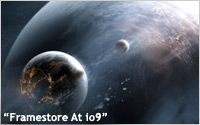 The technology has changed but the
essentials haven't. Whether it’s Melville, Lewis Carroll, David Ogilvy, or BuzzFeed, as screenwriting guru Robert McKee has (probably) put it: "It's about the story, story, story, story."
The technology has changed but the
essentials haven't. Whether it’s Melville, Lewis Carroll, David Ogilvy, or BuzzFeed, as screenwriting guru Robert McKee has (probably) put it: "It's about the story, story, story, story."
The problem is that on the Web, which is becoming more and more a rough mix of narcissism and -- oh yeah -- community, a brand can't just tell a story to an audience. It has to tell a
story that’s also a happening. Actually, Mike Monello, CCO at New York-based marketing agency Campfire, who kicked off at Wednesday’s “Engage: The NYC Digital Storytelling
Conference,” said, people have always been drawn to informal revelations, and public events that seem impromptu, real, and unpredictable.
advertisement
advertisement
He offered Steeplechase Park's
Blowhole Theater as one really good example: back in the beachside amusement park’s heyday, when the eponymous ride ruled the midway, people got off the ride and endured (with masochistic joy) a
gauntlet of cattle prods, hijinks, moving floors and -- most notably -- a floor blower. When women strolled across it, the blower created a Marilyn Monroe effect, to the delight of an endless parade
of gawkers, who had to be ushered in and out in shifts, so popular was the spectacle. Another example: ancient Greek theatre in which the audience was arrayed in a semicircle around a proscenium, as
much to watch themselves as see Sophocles.
"This is storytelling in participatory culture," he said. "People will pay for the privilege of looking at other people. People like
shows, but they like seeing each other, too. That's what powers YouTube."
When it comes to brands telling digital stories, the first step, he said, is creating a communal
experience. "It's less about brand and content than we want to admit."
Monello differentiates the digital audience into three cohorts: skimmers, dippers, and divers -- the
names being pretty self-descriptive. He said the divers -- the fans who really immerse themselves in a brand and love whatever complexities that generates -- should be the major focus. "Divers are a
small group, but they bring in the dippers and the dippers bring in the skimmers [who are repelled by the complexity divers love]."
Jory Benerofe, VP of branding at clothier
Vineyard Vines, discussed how, rather than inventing an artificial narrative to create brand affinity, the company talked about the two brothers who founded the apparel brand, and the idea that its
products are intended, to some extent, as tangible tokens of people’s real experiences, and vacation reminiscences. "When they are at work, and they look down at their [Vineyard Vines] tie, they
will remember their experiences." Just about all of the speakers articulated Monello's themes. "Intrusion is a dead model," said Rob Rasmussen, North American CCO of Story Worldwide.
Framestore, a UK-based firm that has created the cinematic worlds in movies like "Dark Knight," "Avatar," and "Harry Potter," keeps the brainstorming -- the paint and canvas work -- behind
a curtain. It’s an "eyes only" operation for obvious reasons. At least it was.
The agency recently, and for the first time, opened its skunkworks to the public,
reversing the story-then-art paradigm by crowdsourcing stories based on art in an attempt at a Dickens-and-Phiz type symbiosis. Nick Hooker, the firm’s creative director of content, explained
that the experiment was a virtual pipeline from the art studio right to the fervent "divers" of sci-fi and fantasy site io9. It let the Framestore’s artists go right to the fans.
The artists created a series of futuristic, otherworldly murals, put them on the site (something they never would have dreamed of doing) and had fans contribute stories. "We realized that
there was a way to do a stage dive right into that audience," he said. "Rather than being hidden, we lifted the curtain on the art department and built a relationship with [fans]."
Which brought Hooker back to the essential idea that has held water since before the Gutenberg Press: it's about strong stories, whether written or participatory. "Things seem like they are
changing, but actually the fundamentals -- the basics -- don't change."